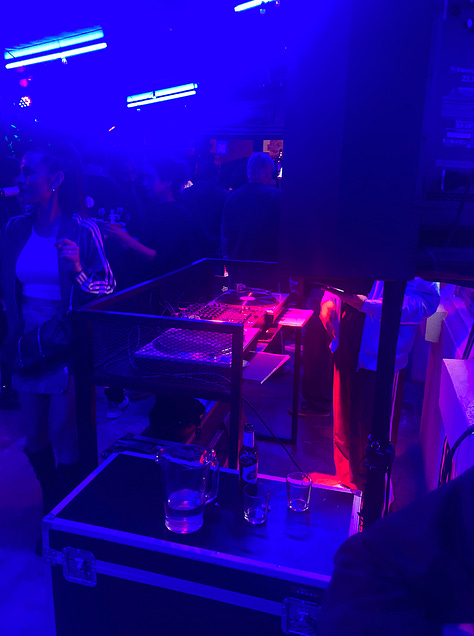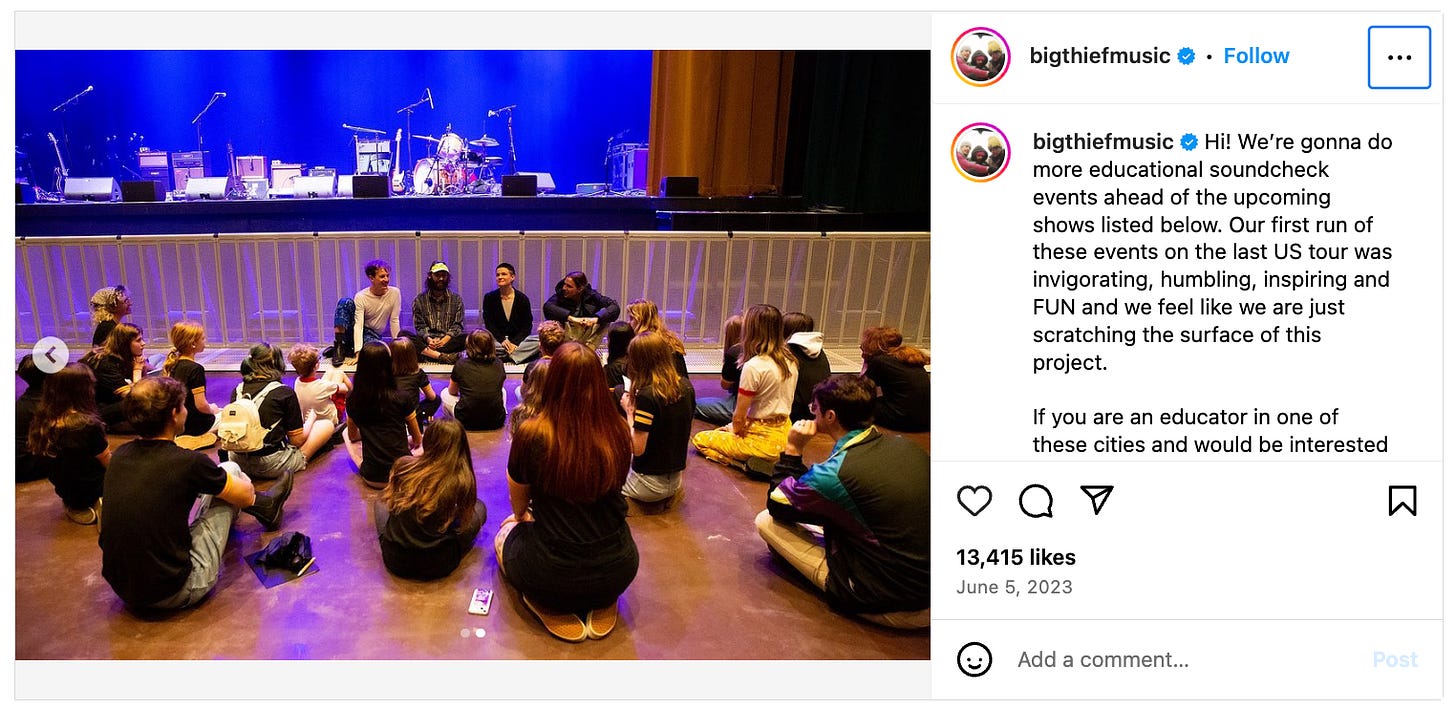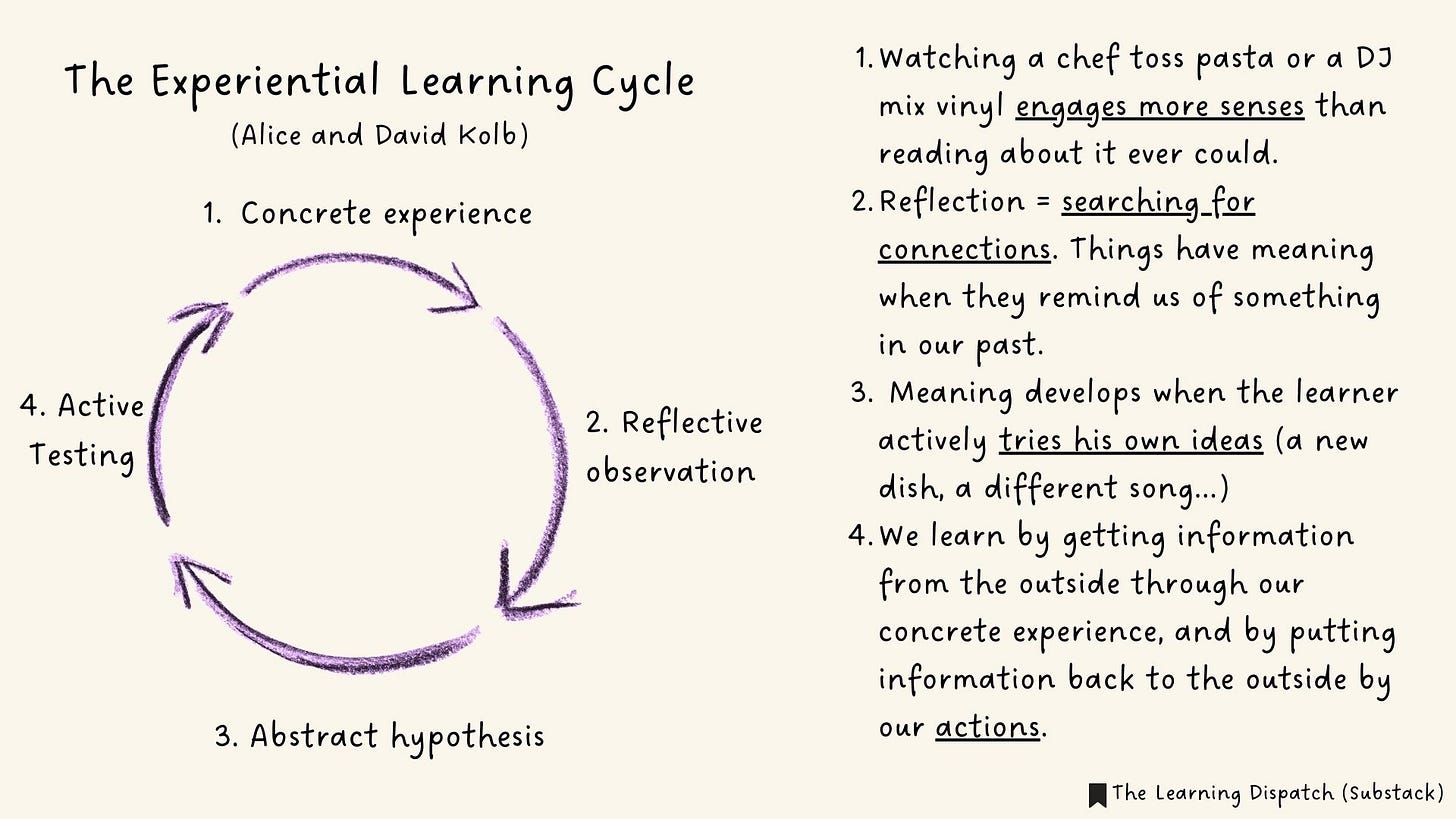“Is this it?”
That’s what we asked our Uber driver as he pulled up to what looked like a warehouse district. Not exactly the venue we imagined. We shrugged and walked toward the entrance, where a police officer and two young women dressed in all black were stationed.“We’re here for the event?” we said, hesitantly. They smiled, checked the list, double-checked our IDs, and welcomed us with warmth that felt totally out of sync with the industrial surroundings. Under a dark sky, framed by the shadows of the warehouses, one building pulsed with purple light. We followed the glow and stepped into another world...

A DJ spun vinyl, his record collection so perfectly arranged it was within arm’s reach of everyone. Anyone could approach him and discuss music for a long time (I mean Fer, of course). And then there was the kitchen. An open kitchen, with about ten people carefully crafting the most exquisite pasta dishes I’ve ever tasted. Chefs wandered in and out, mingling with us mere mortals, swapping stories about food, recipes, and inspiration.





Suddenly, two peculiar figures appeared among the crowd, catching everyone’s attention. They led us upstairs to a room packed with synthesizers and mics. Without warning, music started to flow. The whole evening felt like stepping into a “glass box,” where we could watch —and learn— the craft of DJs, chefs, and musicians up close. Glass Box learning is the format we’re exploring today!
📰 What’s the format?
Glass Box Learning1 is making the process of a craft visible. It’s the opposite of a black box, where you only see the final product. Instead, the focus is on transparency. On letting learners observe the steps, the tools, and even the mistakes that go into creating something remarkable.
This idea of making a craft visible isn’t confined to music or cooking. It’s a timeless learning approach.
From Florence to Open Source
Back in Renaissance Florence, craft guilds thrived on the apprenticeship system. Boys as young as seven would live with masters, learning by doing. They’d start with the basics: mixing paint, prepping canvases, sharpening chisels… and slowly work their way up to more complex tasks. As Bruce Cole writes in The Renaissance Artist at Work:
“The apprenticeship system allowed boys who were probably quite ordinary in every respect to be turned into men possessing a high degree of artistic skill…”
Fast forward a few centuries, and the principle hasn’t changed much. Humans are hardwired to pick up skills from their communities. When we’re immersed in environments rich with expertise, we absorb knowledge through observation and mimicry.
Think of modern apprenticeships or coders learning from open-source repositories. Jack Dorsey, former CEO of X, credits his programming chops to watching experienced developers solve problems and jumping in when he could. And with tools like Replit, novices can now take it a step further, sharing the expert’s workspace in real-time and contributing without disrupting the flow.
Just as Renaissance apprentices learned through observation and participation, modern learners benefit from immersive environments where they can watch experts at work.
One of my favorite examples of this concept is from the music band Big Thief. (Since you’re already here, check out two of my favorite songs):
In 2023, the band extended an open invitation to educators and students to join their soundchecks on their upcoming U.S. tour.
Their goal was to give students a chance to see the soundcheck, ask questions, and join in discussions about creativity, music, songwriting, and playing shows…


Imagine the impact a learning experience like this could have on a high school student! Here’s what some people shared on Reddit:
Kunundrum85 didn’t have the same luck as god_is_ender above (nothing personal with the bankers):
🎛️ What are the features?
Transparency: The process is fully visible.
Accessibility: Learners can observe and participate in meaningful ways,
evenspecially without formal instruction.Immersion: The environment surrounds you with skills, tools, and people practicing the craft.
💡 Why is this format effective for learning?
Let’s refresh Kolb’s Experiential Learning Cycle (I’m a big fan of Big Thief, but a bigger fan of David Kolb).
This format is effective for learning because it taps into all the elements of the experiential learning cycle:
It’s multi-sensory
Watching a chef toss pasta or a DJ mix vinyl engages more senses than reading about it ever could. According to Kolb’s learning theory, this “Concrete Experience” stage creates emotional and cognitive connections that make learning stick.It encourages reflection
Conversations with experts, whether they’re chefs or developers, help learners process what they see, relate it to their knowledge, and connect the dots. Kolb calls this “Reflective Observation.”It fosters experimentation
Seeing pros in action sparks ideas and motivation. Learners can imagine themselves stepping into those roles, and we can now ask them to invent their own ideas and experiment with their own skills.
It builds confidence through action
When learners are immersed in environments where they can try their hand at a task, they gain firsthand experience. Kolb’s “Active Experimentation” phase is where skills are tested, refined, and internalized through real-world practice.

💌 An invitation
Whether it’s music, cooking, coding, or art, Glass Box Learning is about creating spaces where learners can:
Observe the process: Let them see the steps, the mistakes, and the fixes.
Participate meaningfully: Give them tasks they can handle, even if it’s just shadowing or assisting at first.
Ask questions: Encourage dialogue that deepens understanding.
This means letting go of control. Instead of directing every moment, focus on crafting environments where curiosity thrives, and trust that learners will figure it out.

What’s your “glass box”? By making your process visible, you might just inspire the next generation of creators. How can you make your process visible for others to learn? Let me know in the comments! I’m always looking for new ideas (and pasta recipes!)
🏷 Links and Resources
This line of inquiry from Andy Matuschak about tacit knowledge.
Howard’s take on Big Thief’s experiment. You always want to learn from Howard’s take, trust me on this one.
Soundcheck Sessions. A cool initiative that offers young people the chance to visit a venue before it opens to the public, watch the artist performing that night, and participate in a Q&A session with the artist, some of the crew, and the venue team.
🪁 Life Lately
This is a new section! A little peek into what I’ve been up to these days (projects, music, books, and more…)
Reading Meditations for Mortals by Oliver Burkeman (I really enjoyed his previous book Four Thousand Weeks).
Met Juli Muller, a very cool cognitive scientist and reader of the Learning Dispatch! 😮
Preparing to facilitate at the Antigua Forum (this will be my year #6!)
Enjoying Fer’s latest vinyl acquisition: Love in Constant Spectacle.
I appreciate your time. Thank you for reading! 💙
I value your feedback (suggestions, critiques, constructive ideas…) as well as your tips or suggestions for future editions. I’d love to hear about you in the comments.
→ Or just click the heart symbol. That always makes me smile :-)
Inspiration for this name comes from this article by Henrik Karlsson.














Another lovely piece, thanks for sharing.
Thank you for sharing your wonderful experience. Experiential learning certainly is impaction than the traditional approach.